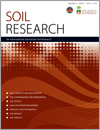SR18299Wet-chemical extractions to characterise pedogenic Al and Fe species – a critical review
Chemical extraction of aluminium and iron is frequently used to characterise forms of these elements developed during soil formation. Depending on the composition of soil, the commonly used extractants may provide incomplete and non-selective extraction. Consequences for soil characterisation and classification are discussed, and alternative methods are suggested.
SR18299 Abstract | SR18299 Full Text | SR18299PDF (324 KB) Open Access Article





